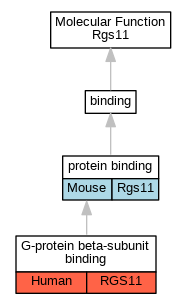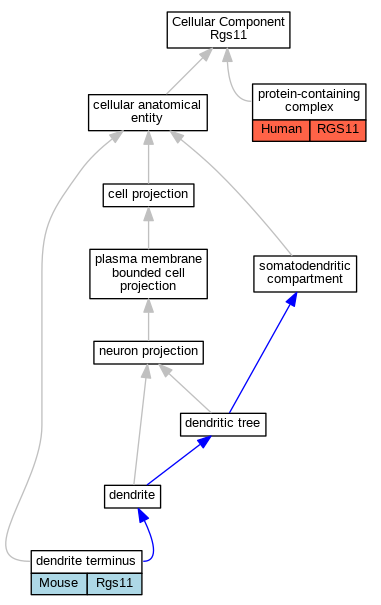|
Source |
Alliance of Genome Resources |



| Category | ID | Classification term | Gene | Evidence | Inferred from | Organism | Reference |
|---|---|---|---|---|---|---|---|
| Molecular Function | GO:0031681 | G-protein beta-subunit binding | RGS11 | IPI | UniProtKB:O14775 | Human | PMID:12606627 |
| Molecular Function | GO:0005515 | protein binding | Rgs11 | IPI | UniProtKB:Q3UVC4 | Mouse | PMID:15897264 |
| Cellular Component | GO:0044292 | dendrite terminus | Rgs11 | IDA | Mouse | PMID:22689652 | |
| Cellular Component | GO:0032991 | protein-containing complex | RGS11 | IDA | Human | PMID:18468998 |
| EXP Inferred from experiment |
| IDA Inferred from direct assay |
| IEP Inferred from expression pattern |
| IGI Inferred from genetic interaction |
| IMP Inferred from mutant phenotype |
| IPI Inferred from physical interaction |
| HTP Inferred from High Throughput Experiment |
| HDA Inferred from High Throughput Direct Assay |
| HMP Inferred from High Throughput Mutant Phenotype |
| HGI Inferred from High Throughput Genetic Interaction |
| HEP Inferred from High Throughput Expression Pattern |
Mouse Genome Database (MGD), Gene Expression Database (GXD), Mouse Models of Human Cancer database (MMHCdb) (formerly Mouse Tumor Biology (MTB)), Gene Ontology (GO) |
||
|
Citing These Resources Funding Information Warranty Disclaimer, Privacy Notice, Licensing, & Copyright Send questions and comments to User Support. |
last database update 07/02/2024 MGI 6.13 |

|
|
|
||